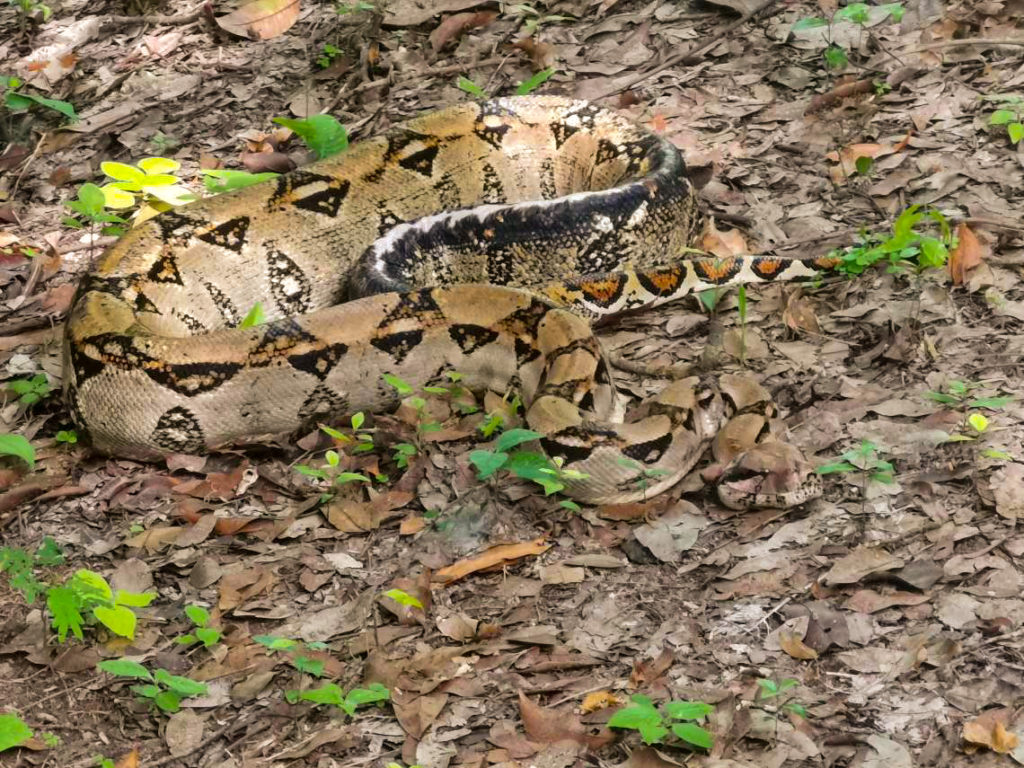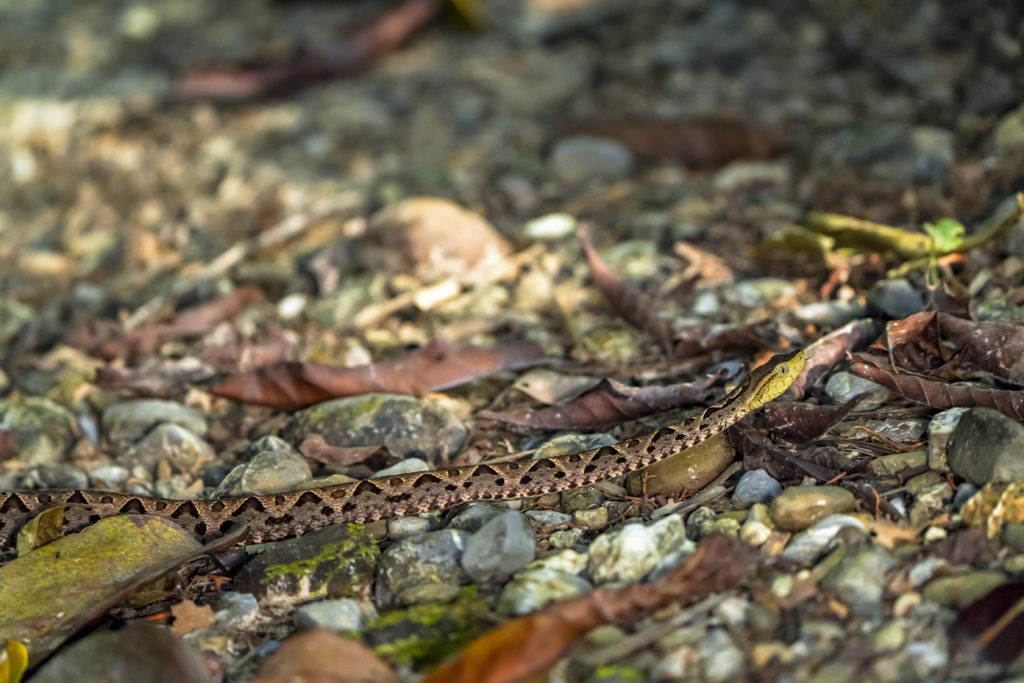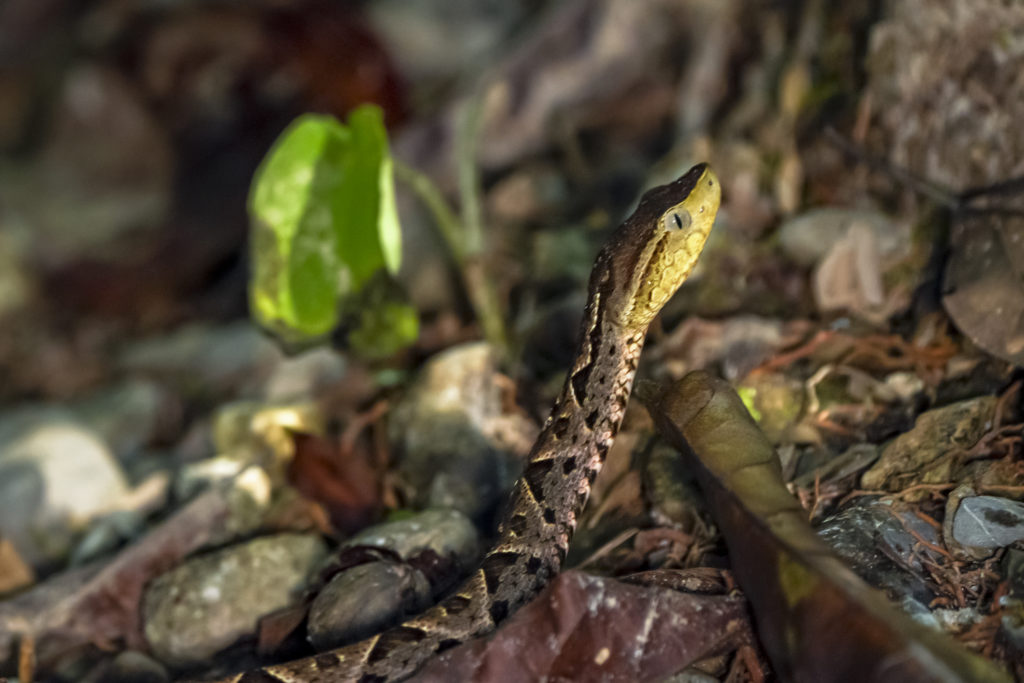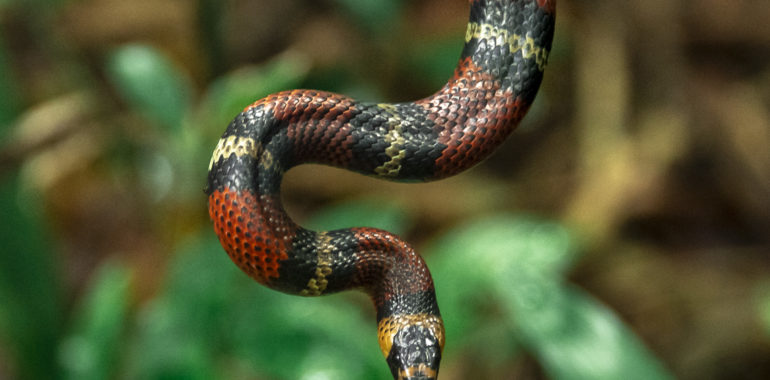Snakes are a group of reptiles belonging to the order Squamata, including lizards. Guatemala has more than 273 species of reptiles. Of which 133 species are snakes. The lowlands of northern Guatemala is the area with the most species with around 73 species, being more than half of the species present in the country.
In the lowlands these 73 species belong to five different families. Being these: Boidae, Leptotyphlopidae Colubridae, Elapidae, Viperidae.
- Boidae. It is the family with the largest species in the country. Boa imperator (mazacuata) is one of the most representative species of this family and the only species of this family found in the northern lowlands. They are large and bulky snakes, which can reach 3 to 4 meters if they live long and full lives. This family has an aglyphous dentition, so they do not have poisonous fangs. They kill their prey by constricting them until they drown. Their diet is quite wide, eating: lizards, birds, and small-medium mammals.

Boa imperator – Mazacuata – Parque Nacional Yaxha, Petén – Photo by Moises Díaz – May. 2020.
- Leptotyphlopidae. It is a group of snakes similar to worms since they live underground or in termite nests. They are quite small and thin, not exceeding 30 cm long. They have rather reduced eyes and a fairly short tail. Their diet is based on termites, ants, and larvae.
- Colubridae. One of the largest families of snakes and with a wide variety of habits. This is where most of the non-venomous snakes belong. This family is represented by a great variety of genera, mentioning Oxybelis, Coniophanes, Drymarchon, and Sibon, to give some examples of genera belonging to this family. They have a wide variety of dentition, the most common is the “opisthoglyph”, which has poisonous fangs in the back of the jaw, so snakes need to bite their victims for a long time to inoculate the poison. The diet of this family ranges from mollusks such as snails, and insects to vertebrates such as amphibians, and lizards to birds and small mammals.

Oxybelis fulgidus – Bejuquilla verde – Tapon Creek, Aldea Buena Vista, Livingston – Photo by Maria Alejandra Gutierrez – Oct. 2020.
- Elapidae. In this family belong the so-called coral snakes, of the genus Micrurus. These snakes have neurotoxic venom, which means that it mainly affects the nervous system of the prey. These snakes have a type of dentition known as “proteroglyphs”, which have fangs at the front of the jaw. These snakes rarely bite humans and are usually quite elusive and can be easily seen during or after rainy nights. These snakes feed mainly on small mammals and lizards. These snakes are distinguished by their coloration patterns which are rings of black, red and yellow. In Guatemala it is quite difficult to distinguish true corals from false corals. Only in the United States can the RANA (Red, Yellow, Black and Yellow) technique be used. This is due to the fact that in Guatemala there are species that do not follow this pattern of coloration in the rings of the body.
- Viperidae. The viper family is one of the most feared. The most poisonous snakes in the country belong to this family. Some species that appear within this family and that are found in the lowlands of northern Guatemala are: Bothrops asper (Lancehead or “Barba amarilla” in spanish), Porthidium nasutum (Hognosed pitviper or “nariz de cerdo” in spanish), Metlapilcoatlus mexicanus (jumping pitviper.or “Mano de piedra” in spanish). These snakes have a dentition known as “Solenoglypha”, this dentition is characterized by having a pair of large fangs with the appearance of needles, which allows these snakes to inoculate their venom. Unlike Elapidae venom, viperidae venom is hemotoxic, meaning that the venom affects the tissues and spreads through the blood. The poison causes a necropsy in the affected area and if the bite is not treated in time, the affected person can die. These snakes feed mainly on small mammals such as mice, occasionally feeding on birds and lizards.
![]()
Porthidium nasutum – Cerro San Gil, Quebrada del Ávila – Photo by Senaida Ba – Google Pixel 3XL – Jan. 2021.
The case of Bothrops asper, the – Central American Lancehead
The or also called “Barba amarilla” in Guatemala (Yellow beard) is known and feared throughout the north of Guatemala. Its reputation is not for nothing, because this is the most poisonous snake in all of Guatemala. This is one of the snakes that cause the most ophidic accidents per year, this is because this snake adapts quite well to the disturbance of the areas. So it is normal to have encounters with this snake in the field, on many occasions people cannot see the snake, and it bites them when it feels threatened. Due to this, people come to kill at the sight of one.

Bothrops asper – Barba amarilla – Biotopo Chocón Machacas, Río Dulce, El Golfete, Livingston – Photo by David Arrivillaga – Jan. 2021
This snake is one of the largest, reaching 2 to 3 meters long. These have keeled scales around the body, and a beige and brown coloration, in the part of the lower jaw they have a yellowish coloration (reason why it receives its common name of “Barba amarilla” in spanish). It has vertically elliptical eyes that resemble a cat’s. The venomous fangs can reach more than 5 cm. It is a species of nocturnal and terrestrial habits, only juveniles can be found in the treetops.
The form of reproduction of this snake is viviparous, so they do not lay eggs, instead the females give birth to live young. A single female can give birth to more than 80 offspring in a single clutch. These at birth have enough poison to kill a human. They feed mainly on mice and small animals. Despite being a fairly feared snake, it plays a very important role in nature, since it keeps rodent populations low and prevents their overpopulation.

Bothrops asper – Barba amarilla – Biotopo Chocón Machacas, Río Dulce, El Golfete, Livingston – Photo by David Arrivillaga – Jan. 2021
The diversity of snakes in the country is quite extensive, from harmless snakes that do not represent any danger to deadly poisonous snakes. All these species of this group have a very important role in ecosystems. Such as avoiding the overpopulation of many pests like rodents and even being the food of many other organisms such as the prey of hawks and owls. The venom of snakes is also of medical importance, since it is from the venom itself that anti-venoms can be used, and it is currently being studied that other medicines can be made from the venom of these animals. Therefore, the role played by these animals is quite important not only within ecosystems but also within the area of human medicine.
Bibliography
- 1998
- Amphibians and Reptiles of Northern Guatemala, the Yucatan, and
Belize. University of Oklahoma Press, Norman, Oklahoma.
- 2008
- Reptiles of Central America. Herperon Verlag Elke Kohler, 2nd Edition.
400 páginas.
- 2000
- A field guide to the Amphibians and reptiles of the Maya World. The
Lowlands of Mexico, Northern Guatemala, and Belize. Comstock Publishing Associates, Cornell University Press

